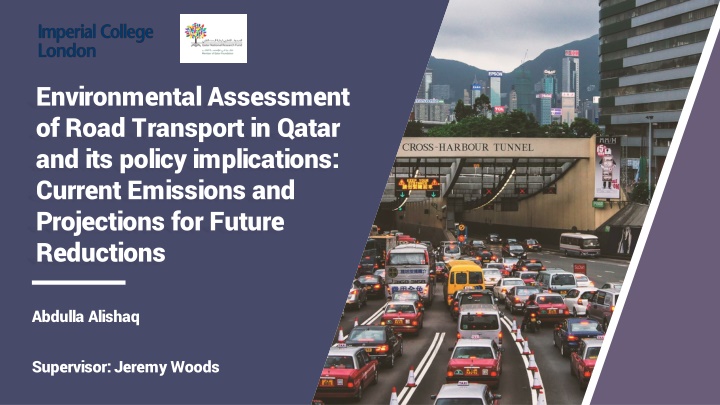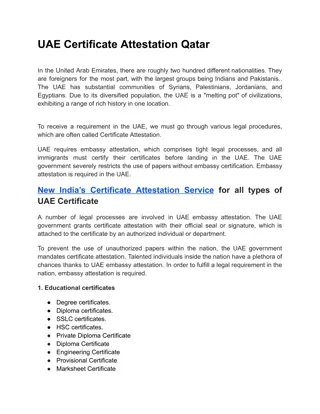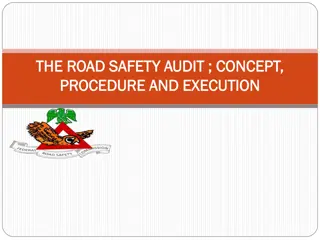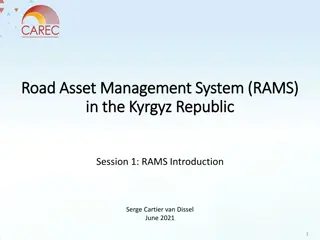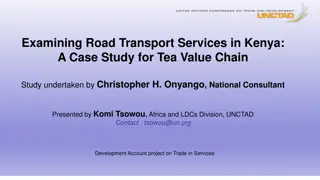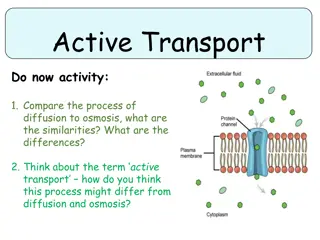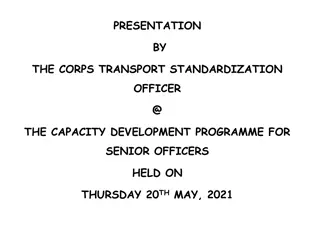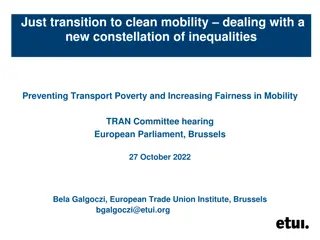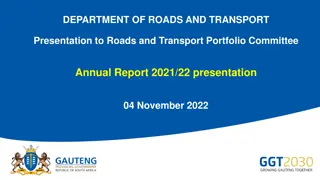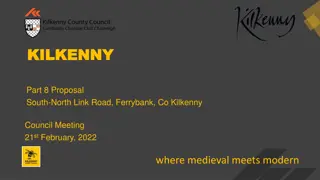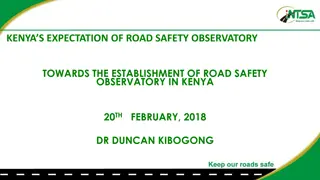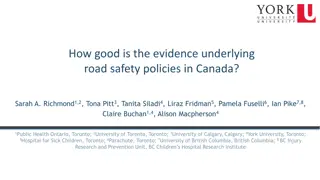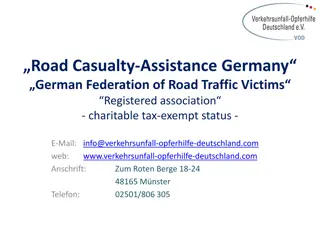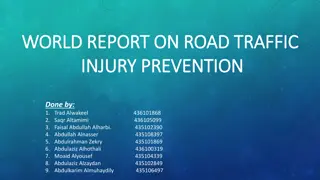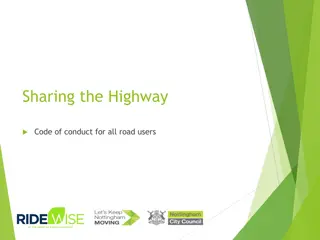Environmental Assessment of Road Transport Policies in Qatar
This research delves into assessing current emissions and projecting future reductions in road transport in Qatar, with a focus on GHG and air pollution. The study aims to determine effective policies for achieving emission reduction goals by 2030 and 2050, exploring fleet configurations, electrification impacts, and potential vehicle ban scenarios. Methodologies include scenarios analysis, stock flow modeling, and dynamic life cycle assessments to decarbonize Qatar's transportation sector.
Download Presentation

Please find below an Image/Link to download the presentation.
The content on the website is provided AS IS for your information and personal use only. It may not be sold, licensed, or shared on other websites without obtaining consent from the author.If you encounter any issues during the download, it is possible that the publisher has removed the file from their server.
You are allowed to download the files provided on this website for personal or commercial use, subject to the condition that they are used lawfully. All files are the property of their respective owners.
The content on the website is provided AS IS for your information and personal use only. It may not be sold, licensed, or shared on other websites without obtaining consent from the author.
E N D
Presentation Transcript
Environmental Assessment of Road Transport in Qatar and its policy implications: Current Emissions and Projections for Future Reductions Abdulla Alishaq Supervisor: Jeremy Woods
Background: GHG and Air Pollution The Transport Sector Research Aim Research Methods Presentation Outline Initial Results Conclusion and Future Work Reference
Background: GHG and Air Pollution 01 02 03 Highest CO2 per capita Heavily involved in oil and gas business 12th most polluted city Hydrocarbons accounted for 91% of exports PM2.5 31.1 tonnes vs 4.8 tonnes WHO Standard: 10 g/m^3 Qatar: 90 g/m^3 126 million tonnes of LNG production by 2027 PM10 WHO Standard: 20 g/m^3 Qatar: 50 g/m^3
The Transport Sector 8.5 billion tonnes of CO2eq in 2019 GHG 7.67/12 mega tons of CO2eq in 2019 7% of national emissions Road vehicles are responsible for 45% 50% of PM emissions in OECD emissions 1.5 million road vehicles 300,000 vehicles in 2000 800,000 vehicles in 2010 1.5 million vehicles in 2018 Electricity 4% of road fleet by 2022 Electricity 10% of road fleet by 2030 Reduce road emissions by 25% by 2030 Targets
Research Aim The aim of this research is to determine which policies should Qatar adopt for road transport this decade to put it on track to achieve 2030 and 2050 goals. Research questions: What fleet configuration of would achieve the GHG reduction goals by 2030 and how would vehicle ban scenarios affect emissions? What are the necessary measures to decarbonize the transportation sector in Qatar by 2050? What is the dynamic LCA from cradle to grave of a BEV in comparison to an ICEV operating in Qatar?
Methodology Scenarios analysis for road transport 1- Current GHG and air pollution emissions? Stock Flow Model Survival and scrappage rate Inflow and outflow of vehicles 2- How to get a 25% reduction? Fuel source LDV, HDV, buses, and motorcycles Fuel economy 3- Impact of 10% electrification by 2030? Vehicle kilometres travelled LDV: sedans, SUV, and sports vehicles 4- Impact of ICEV ban? Curb mass
Methodology Scenarios analysis for road transport Average transport activity per person per mode (pkm/person) Population Total average transport activity per mode (pkm) Occupancy rate (pkm/vkm) Vehicle transport distance per mode (vkm) Technology Share (%) Vehicle transport distance per mode per technology (vkm) Energy intensity per mode per technology (MJ/vkm) Emission factor per mode per technology (kgCO2eq/MJ) Total GHG emissions (kgCO2eq)
Methodology Emission projections using the transition pathway explorer
Methodology Emission projections using the transition pathway explorer
Methodology Life Cycle Assessment LDV+ HDV+ Buses LDV: Sedans, SUV, Sports Vehicles BEV + ICEV + Diesel Life Cycle Assessment Dynamic Life Cycle Assessment Literature Powertrain Type of LDV Impact Assessment Method TRACI Database Boundary Al-Thawadi, Weldu and Al- Ghamdi ICEV Not Specified GaBi Database Gate to Gate Al-Thawadi and Al-Ghamdi ICEV Not Specified ReCiPe GaBi Database Gate to Gate Onat, Kucukvar, Aboushaqrah, and Jabbar ICEV, HEV, PHEV, BEV SUV Multi-Region Input- Output EXIOBASE 3.4 Gate to Gate This Study ICEV and BEV Sedans, SUVs, and Sports Cars CML Ecoinvent Cradle to Grave
Initial Results Scenarios analysis for road transport CO2 Emissions from LDVs Total CO2 Emissions from All Road Vehicles 100% 1.E+07 80% CO2 Emissions (t) CO2 Emissions (t) 8.E+06 6.E+06 60% 4.E+06 2.E+06 40% 0.E+00 20% 0% Year 2014 2015 2016 2017 2018 LDV HDV Buses Motorcycles Sedans SUVs Sports Vehicles
Initial Results Life Cycle Assessment Global Warming (GWP100a) Eutrophication 0.40 9.E-04 8.E-04 0.35 KG CO2 EQ PER KM KG PO4 EQ PER KM 7.E-04 0.30 6.E-04 0.25 5.E-04 0.20 4.E-04 0.15 3.E-04 0.10 2.E-04 0.05 1.E-04 0.00 0.E+00 ICEV Sedan ICEV SUV ICEV Sport Vehicle BEV Sedan BEV SUV BEV Sport Vehicle ICEV Sedan ICEV SUV ICEV Sport Vehicle BEV Sedan BEV SUV BEV Sport Vehicle
Conclusion and Future Work Develop road scenarios to achieve local goals, and measure the effectiveness of ban policies 01 02 Begin working on the transition pathway explorer model 03 Model the dynamic LCA for different vehicle types and classes
References Al-Thawadi, F. E., & Al-Ghamdi, S. G. (2019). Evaluation of sustainable urban mobility using comparative environmental life cycle assessment: A case study of Qatar. Transportation Research Interdisciplinary Perspectives, 1(2019), 100003. Garcia, R., & Freire, F. (2017). A review of fleet-based life-cycle approaches focusing on energy and environmental impacts of vehicles. Renewable and Sustainable Energy Reviews, 79(August 2016), 935 945. 1 5 Al-Thawadi, F. E., Weldu, Y. W., & Al-Ghamdi, S. G. (2020). Sustainable Urban Transportation Approaches: Life-Cycle Assessment Perspective of Passenger Transport Modes in Qatar. Transportation Research Procedia, 48, 2056 2062. 2 6 Taylor, E., Martin, B., Latiers, M., Cornet, M., & Pestiaux, J. (2020). Transport Module Documentation. Onat, N. C., Kucukvar, M., Aboushaqrah, N. N. M., & Jabbar, R. (2019). How sustainable is electric mobility? A comprehensive sustainability assessment approach for the case of Qatar. Applied Energy, 250, 461 477. eucalc. (n.d.). Retrieved June 20, 2022, from http://tool.european- calculator.eu/app/emissions/ghg- emissions/?levers=1j12112ffl11211mp2b111fffffpppppp11f411111e3211r 211l21n221 3 7 Qatargas. (2020b). Retrieved December 1, 2020, from https://www.qatargas.com/english/MediaCenter/Pages/Press Releases/Qatar-Petroleum-Announce-the-Start-of-the-Development- Drilling-Campaign-of-the-North-Field-East-Project.aspx 4 8 Ministry of Interior. (2019). TRANSPORT AND COMMUNICATIONS STATISTICS.
